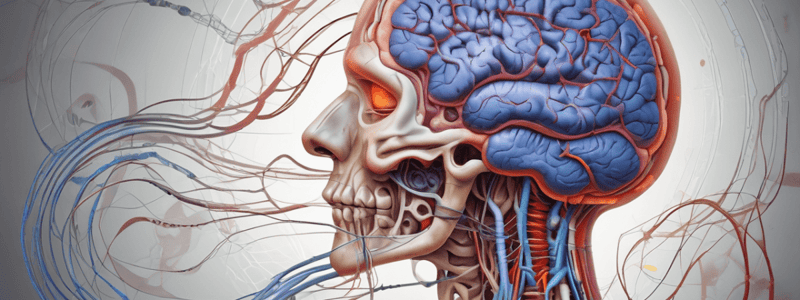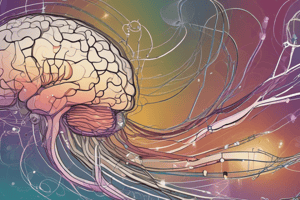Podcast
Questions and Answers
Which major Ach producing nucleus is found in the brainstem?
Which major Ach producing nucleus is found in the brainstem?
- Nucleus basalis
- The medial septal nucleus
- Pedunculopontine nucleus (correct)
- Diagonal band
Which of these Ach receptor types is ionotropic?
Which of these Ach receptor types is ionotropic?
- Nicotinic (correct)
- Muscarinic M5
- Muscarinic M1
- Muscarinic M4
What role does Ach play in brain function?
What role does Ach play in brain function?
- Cognition (correct)
- Blood pressure regulation
- Vision
- Balance
Which substance inhibits the vesicular acetylcholine transporter in a typical Ach synapse?
Which substance inhibits the vesicular acetylcholine transporter in a typical Ach synapse?
Which 5HT receptor subtype is not metabotropic?
Which 5HT receptor subtype is not metabotropic?
Which drug is known as a 5HT3 antagonist?
Which drug is known as a 5HT3 antagonist?
What enzyme is responsible for converting glutamate to GABA?
What enzyme is responsible for converting glutamate to GABA?
Which neurotransmitter is NOT a monoamine?
Which neurotransmitter is NOT a monoamine?
Which of the following substances inhibits the dopamine transporter leading to an increase in dopamine release?
Which of the following substances inhibits the dopamine transporter leading to an increase in dopamine release?
Which dopamine receptor is a part of the five DA receptors in the brain?
Which dopamine receptor is a part of the five DA receptors in the brain?
Which of the following is an antagonist to α₁ receptors in the noradrenergic system?
Which of the following is an antagonist to α₁ receptors in the noradrenergic system?
Which of the following inhibits the enzyme COMT?
Which of the following inhibits the enzyme COMT?
What is the primary role of norepinephrine (NA) in brain function?
What is the primary role of norepinephrine (NA) in brain function?
Which major dopamine nucleus is located in the brainstem?
Which major dopamine nucleus is located in the brainstem?
Which neurotransmitter is the major excitatory neurotransmitter throughout the nervous system?
Which neurotransmitter is the major excitatory neurotransmitter throughout the nervous system?
What is the primary function of GABA in the brain?
What is the primary function of GABA in the brain?
Which class of neurotransmitter does acetylcholine belong to?
Which class of neurotransmitter does acetylcholine belong to?
Which of the following is NOT a class of GABA receptors?
Which of the following is NOT a class of GABA receptors?
What is one role of glutamate in brain function regarding health?
What is one role of glutamate in brain function regarding health?
What is the consequence of dysregulation of glutamate activity?
What is the consequence of dysregulation of glutamate activity?
Which of the following is not one of the glutamate receptors?
Which of the following is not one of the glutamate receptors?
Which enzyme converts glutamine to glutamate?
Which enzyme converts glutamine to glutamate?
What is required for optimal brain function?
What is required for optimal brain function?
Where are neurotransmitters typically stored?
Where are neurotransmitters typically stored?
Which of the following is NOT a criterion for a chemical to be classified as a neurotransmitter?
Which of the following is NOT a criterion for a chemical to be classified as a neurotransmitter?
What is the role of mitochondria in the presynaptic terminal?
What is the role of mitochondria in the presynaptic terminal?
What is the function of the synaptic vesicles?
What is the function of the synaptic vesicles?
What are secondary messengers?
What are secondary messengers?
What is the main difference between agonists and antagonists?
What is the main difference between agonists and antagonists?
What happens when neurotransmitters bind to receptors?
What happens when neurotransmitters bind to receptors?
Where do neurotransmitters have their effect?
Where do neurotransmitters have their effect?
Which organelles in the presynaptic terminal are responsible for packaging neurotransmitters?
Which organelles in the presynaptic terminal are responsible for packaging neurotransmitters?
Flashcards are hidden until you start studying
Study Notes
Neurotransmitters
- Neurotransmitters are chemicals that transmit signals between neurons.
- For optimal brain function, neurons need to communicate with each other using electrical and chemical signals.
Classification of Neurotransmitters
- A chemical must meet three criteria to be considered a neurotransmitter:
- Be synthesized and stored in presynaptic neurons
- Be released by presynaptic axon terminals
- Produce responses in postsynaptic cells
Structure of a Typical Synapse
- Presynaptic terminal: the end of an axon that forms the synapse
- Mitochondria: provides energy for synaptic transmission
- Secretory granules: contain chemicals (usually neuropeptides) released from the axon terminal to activate receptors on surrounding neurons
- Synaptic cleft: the area between the presynaptic terminal and the postsynaptic regions
- Synaptic vesicles: small organelles in which neurotransmitters are packaged
- Active zone: the part of the presynaptic region where synaptic vesicles dock and are released
- Postsynaptic density: a region of the postsynaptic membrane enriched with receptors
Glutamate
- The major excitatory neurotransmitter throughout the nervous system
- Expressed in almost all brain regions
- Binds to its receptors, causing excitation of neurons
- Two classes of Glutamate receptors:
- Ionotropic (NMDA, AMPA, Kainate)
- Metabotropic (mGluR, with 8 subclasses)
- Important for learning, memory, and cognition
- Dysregulation can lead to excessive neuronal excitability, seizures, and excitotoxicity
GABA
- The major inhibitory neurotransmitter in the brain
- Binds to its receptors (GABA-R), resulting in the inhibition of neuronal activity
- Three classes of GABA receptors:
- GABA-A
- GABA-B
- GABA-C
Dopamine
- Synthesized from tyrosine
- Has five receptors: D1, D2, D3, D4, and D5
- Important for:
- Motor coordination
- Motivation
- Reward seeking
- Cognition
- Nausea and vomiting
- Hormonal regulation
- Receptors are metabotropic, causing excitation or inhibition depending on the G-proteins they are coupled to
Noradrenaline (NA)
- Synthesized from tyrosine
- Has three types of receptors: Alpha 1 & 2, and Beta 1, 2, and 3
- Important for:
- Arousal
- Memory and cognition
- Stress response
- Receptors are metabotropic, causing excitation or inhibition depending on the G-proteins they are coupled to
Acetylcholine (ACh)
- Synthesized from choline
- Has two classes of receptors:
- Nicotinic (ionotropic)
- Muscarinic (metabotropic)
- Important for:
- Cognition
- Motor activity
- Mood
- Receptors are either ionotropic or metabotropic, causing excitation or inhibition depending on the G-proteins they are coupled to
Serotonin (5-HT)
- Synthesized from tryptophan
- Has seven subclasses of receptors
- Important for:
- Sleep
- Pain
- Emotion
- Receptors are metabotropic, causing excitation or inhibition depending on the G-proteins they are coupled to
Studying That Suits You
Use AI to generate personalized quizzes and flashcards to suit your learning preferences.




